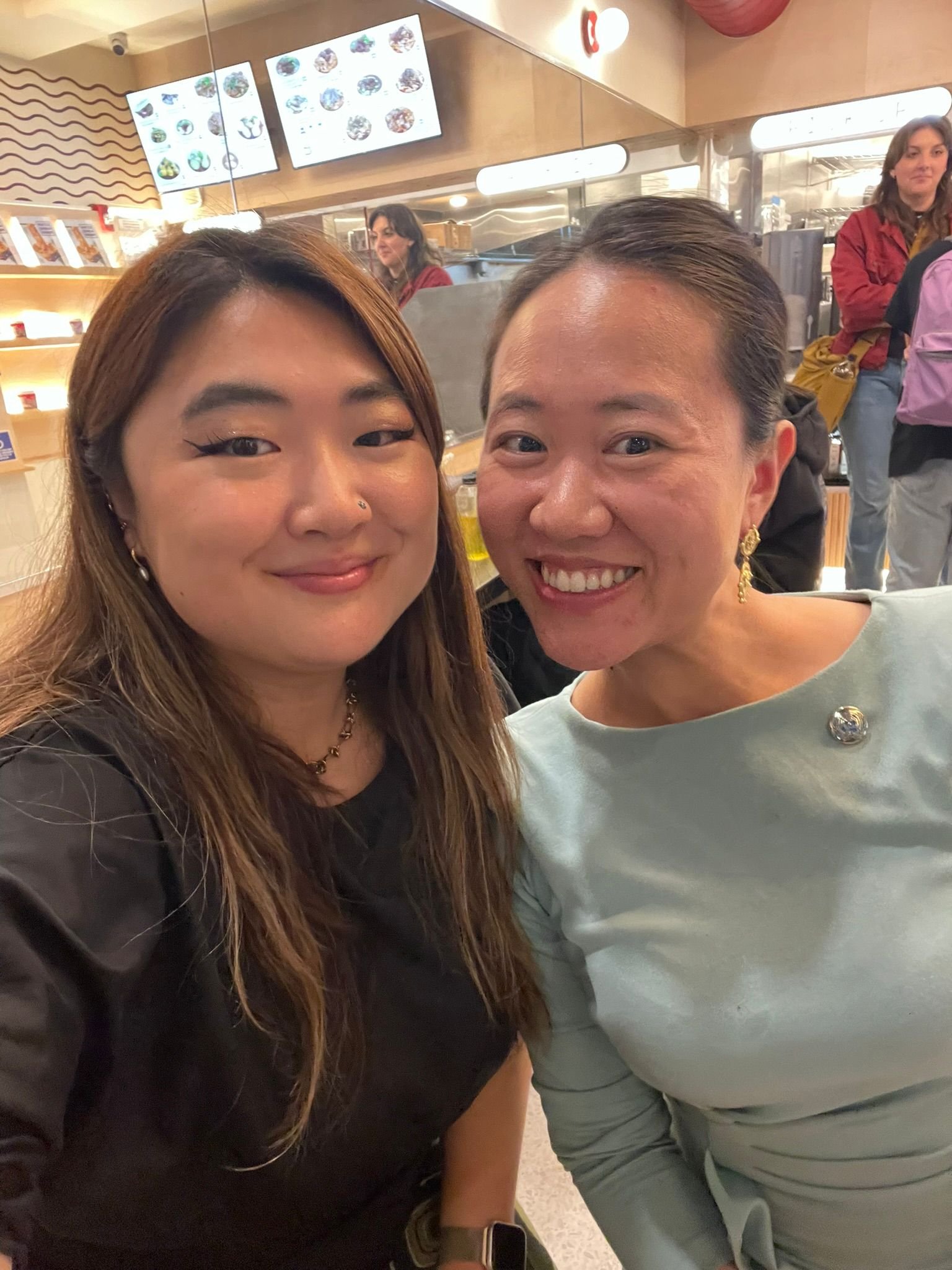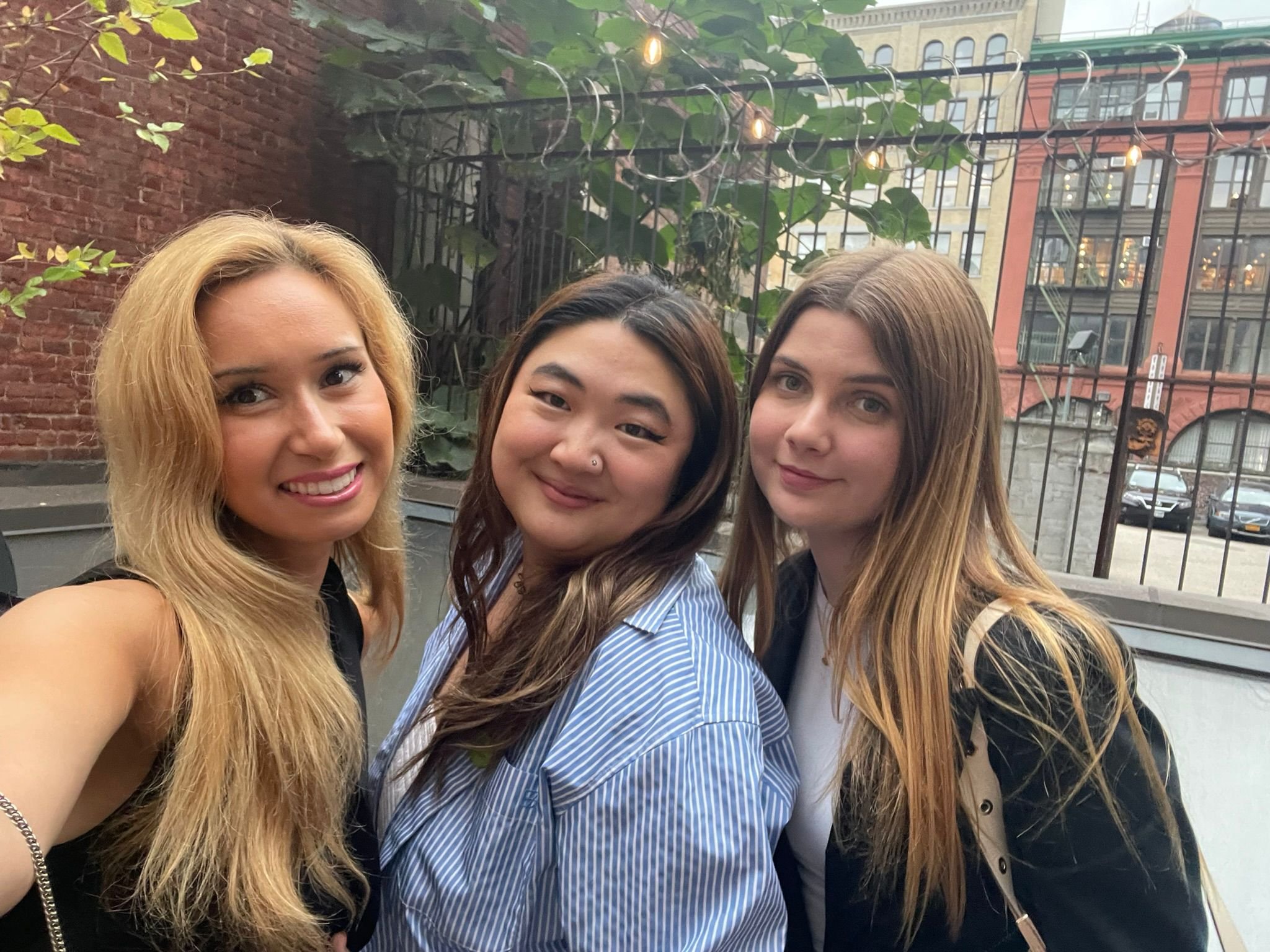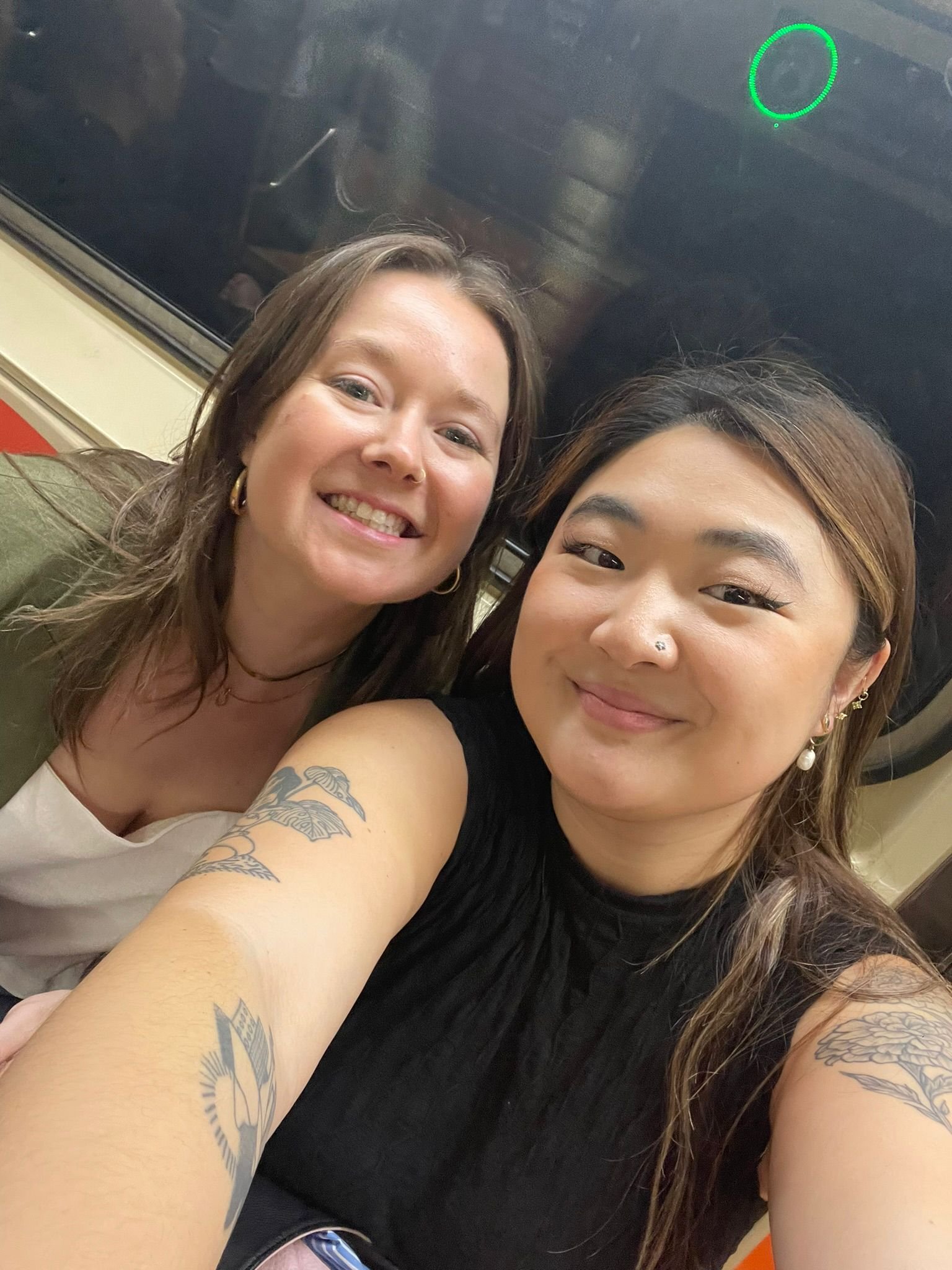Recap of New York Climate Week 2024: Innovation, Collaboration, and Mobilization
Written by: Sophia Yang, Founder & Executive Director, and Luiza Giocondo Teixeira, Communications & Engagement Director @Threading Change
October 24, 2024
[10-minute read]
New York Climate Week 2024 is likely the biggest climate gathering in 2024, bringing together leaders, innovators, and activists to confront today’s most pressing climate challenges. This was Threading Change’s first time attending NY Climate Week as a delegation, and it was a big success! We look forward to future activations and engagement opportunities in New York Climate Weeks to come. Read on to see a detailed recap of what we got up to!
Representing Threading Change, our Founder and Executive Director, Sophia Yang (on the right), and our Communications & Engagement Director, Luiza Giocondo Teixeira (on the left), attended several transformative sessions.
From sustainability strategies to the intersection of fashion and technology, the event fostered inspiring discussions and opened doors to impactful partnerships.
Event highlight 1. Sophia Yang on the Main Stage: Fashion, Finance & Impact at Ambition Loop’s Runway for Change
A major highlight was our Founder, Sophia’s participation in UN Ambition Loop's Runway for Change: Fashion, Finance & Impact panel, hosted at Regeneration.VC’s head office in New York. Speaking alongside industry leaders such as Eva Kruse (PANGAIA & Global Fashion Agenda), Sheila Aggarwal-Khan (UNEP), and Matt Dwyer (Patagonia), Sophia delivered a dynamic address on the importance of investment in global youth to accelerate the shift toward ethical fashion.
Reflecting on the session, Sophia remarked:
"It feels surreal to be on the main stage, discussing a topic I’m passionate about—mobilizing investment and financing for youth to advance sustainable fashion. Every day of Climate Week has been packed with meaningful conversations, connections, and collaborative efforts to drive positive change in the fashion and circular economy industries."
The above slide is one Threading Change presented during the presentation details the need for philanthropy and global youth engagement in fashion and the circular economy.
The 'Runway for Change: Fashion, Finance & Impact' event brought together world leaders in fashion. Ranging from brands, government entities, innovators, and NGOs. Sophia focused her speech on the dire need to fund fashion justice work, especially in countries such as Kenya, where the Global North's greedy consumption patterns contribute to a vast textile waste dumping ground.
Event highlight 2. Sophia Yang as the Youth Representative at the World Business Council for Sustainable Development (WBCSD)’s Futures 2050 event
Sophia also gave the youth intervention at the World Business Council for Sustainable Development (WBCSD) Futures 2050 event, where the Global Circularity Protocol (GCP) was launched. The protocol is a voluntary framework that aims to address key accountability and policy gaps currently impeding the scaling of circularity globally.
As the only youth representative with a speaking slot in the room, Sophia highlighted the importance of meaningful youth inclusion:
“More than half of the world's population is under 30 years old. By 2050, the young population in Africa is expected to double, with about 60% of the population under 25. By 2030, the number of young people is expected to grow to nearly 1.3 billion.
Despite half of the world's population being under 30, only 2.6% of parliamentarians globally are in this age group. We are not always represented in these spaces, but we will be the future workforce that’s helping to bring these protocols, policies, and metrics to life.
In fashion especially, young people are not properly engaged, but tokenized.
With your leadership and positionality, please think about designing employment programs and incentives for global youth, especially those in the most affected and vulnerable communities of climate change, to play a vital role in ensuring that we actualize the circular economy future we so desperately need. But this isn’t something we can do alone. We need governments, policymakers, investors, businesses, and everyone onboard to ensure that everything we’re discussing isn’t just idealistic, but actually implemented.”
Photo: Sophia delivering the closing youth intervention at WBCSD’s Futures 2050 event.
“We can’t just be talking about sustainability from a purely carbon reduction perspective, we need verifiable data, this needs to be included in the solution. Furthermore, the private sector has a massive role, and a responsibility to invest in the climate and tech solutions, and the investment must be continual beyond the pilot stage. We can’t fall privy to pilot paralysis, and innovations not being able to scale and implemented globally.” - Sophia Yang
Sophia’s role in the intervention was to summarize the points from the second panel at the Futures 2050 event, while sharing her own thoughts, she also remarked:
“I’m inspired by Dr. Uehara remarks in stating that the consumer plays a role when it comes to responsible use. And they absolutely do, with policies and social conditioning in place, consumers and citizens can be champions of change. I had the privilege of vacationing in Japan for 2 weeks in july this year, and was amazed by how incredibly clean it was, with signs everywhere letting citizens know to take their trash back to their homes. And isn’t this what extended producer responsibility is all about? To ensure that businesses are responsible for their waste, we ca do the same for consumers, we must develop programs that incentivize players to do the right thing, it has been done successfully.”
Lastly, Sophia highlighted the urgent need for funding to support these policy frameworks, asking the audience and the panel to reflect on how mobilizing more philanthropic capital for the transition to a circular economy can be accomplished, whilst leaving no one behind. Additionally, how we can ensure youth engagement while using the SDGs as a tool for maximum impact.
The above slide is one Chatham House presented during the event, which details how circular economy targets and goals can fit in very well with the UN SDGs. This body of research compliments Threading Change’s SDGsxFashion Policy Program perfectly.
Event highlight 3. UNEP and Global Fashion Agenda: Communications Roundtable
During an insightful session with UNEP, Sophia and Luiza explored strategies for influencer engagement to shift consumer behavior toward sustainable fashion.
Key Takeaways
The Power of Storytelling: Rachel from UNEP stressed that storytelling is crucial not only for raising awareness but also for demonstrating tangible ways to make change. The goal isn’t to stop enjoying fashion but to reimagine how we engage with it.
Bridging the Global Gap: A disconnect persists between consumers in the Global North (Canada, USA, and Europe) and communities in Kenya and other regions negatively impacted by fast fashion. A TikTok trend led by Threading Change’s Africa Regional Coordinator, Janet Chemitei, showcased textile waste in Kenya, amassing 10 million views—an example of how authentic, relatable content resonates with global audiences.
Engaging Influencers with Purpose
Fear of Greenwashing: Influencers often hesitate to engage with sustainability topics due to concerns about being labeled as greenwashers. Non-profits like Threading Change can ease this burden by aligning collaborations with influencers’ content styles and briefing them on product sustainability attributes.
Making Sustainability Accessible: Second-hand shopping connects easily with audiences, but more complex concepts like circularity require creative storytelling to engage effectively.
Event highlight 4. Fusion Fashion Tech Summit: Technology and Fashion for a Circular Future
At the Fusion Fashion Tech Summit, industry leaders discussed how digital innovation can drive supply chain transparency and foster a circular economy.
A Call for Systemic Change
Aderinola advocated for Extended Producer Responsibility (EPR) to ensure manufacturers are held accountable for the entire lifecycle of their products.
Marci Zaroff shared an inspiring example of pineapple fiber being used to create fabrics that resemble cotton, highlighting the potential of innovative textiles. She also pointed out the disconnect between supply chains and field practices, underscoring the need for education to bridge this gap.
The Intersection of Technology and Circular Fashion
AI in the Supply Chain: Ann Rosenberg emphasized the role of artificial intelligence in enhancing supply chain transparency.
3D Fitting Technology: Elizabeth Aderinola highlighted 3D fitting as a solution to reduce waste and help consumers make informed purchasing decisions.
Urban Development and Biomimicry: Discussions also explored how nature-inspired design and urban planning can further accelerate the transition to a circular economy.
The Promise of Digital Product Passports (DPPs)
In the near future, products sold within the European Union will feature DPPs, providing detailed environmental footprints to help consumers make responsible choices.
Nina Shariati noted that while DPPs can accelerate the shift from a linear “take-make-waste” economy to a circular model, funding challenges persist. Investors often struggle to align sustainable innovations with traditional, profit-driven economic models. Shariati urged for a reimagining of economic systems, where externalities like clean air are factored into value assessments.
The summit also revealed a paradox in the circular economy narrative: the belief that overconsumption can continue if products are circular. Shariati warned against falling into this trap, explaining that circularity alone isn’t enough—long-term changes in consumer behavior and regulation are essential.
Looking Ahead: A Collaborative Path to Sustainability
New York Climate Week 2024 underscored that collaboration between fashion, tech, and policy sectors is crucial for driving sustainable change. At Threading Change, we are inspired by the insights gained and remain committed to:
Advocating for transparency by supporting standardized impact metrics and tools like Digital Product Passports.
Engaging consumers to shift mindsets toward rewearing clothes and rejecting overconsumption.
Partnering with tech leaders to develop innovative tools, such as AI-powered supply chains and 3D fitting technologies.
We extend heartfelt gratitude to Ambriel for inviting us to the Fusion Fashion Tech Summit, and to all the incredible panelists who contributed their expertise. These events reaffirmed our belief that the intersection of fashion, technology, and sustainability holds immense potential—but only through systemic change and collaborative action can we achieve a truly circular economy.
We are excited to continue building on these conversations and partnerships, working toward a future where fashion is not only beautiful but also ethical and sustainable.
Below you will find pictures of all our amazing collaborators and partners that we met up with in person during NYCW. Thank you for your continued support in the last year, and we look forward to Threading more Change together!





Next Steps for Threading Change
This session with UNEP gave us actionable insights to enhance our work with influencers and content creators. Moving forward, Threading Change will:
Collaborate with local influencers in regions impacted by fast fashion, such as Kenya, to bridge the narrative gap for audiences in the Global North.
Focus on second-hand fashion as an accessible entry point for consumers to explore sustainable practices.
Develop briefs for influencers to streamline partnerships, reducing the fear of greenwashing and building their confidence to engage in sustainability messaging.
Explore TikTok trends that resonate with personal life and emotions to maximize impact.
Through these strategies, we aim to convert engagement into real-world action, empowering audiences to make responsible choices and reshape the fashion industry for a more sustainable future.
It was an incredible experience to represent global youth on the world stage when discussing the importance of meaningful youth inclusion in fashion and the circular economy.
We are grateful to WBCSD, UN Ambition Loop, Global Fashion Agenda, UNEP, Solutions House, and Regeneration.VC for hosting us at their events. New York Climate Week was very jam-packed and busy, but definitely also very rewarding.
We are also thankful to our fashion partners for the ongoing collaboration all of these years, they include: Fashion Revolution, Sophia Li, NY Fashion Act, the Weird and Wild, DNA.Threads, Youth Climate Collaborative, and the Global Shapers Community. Thank you all so much, onwards and upwards!
About the authors:
Sophia is the Founder & Executive Director of Threading Change, the world’s leading for youth, by youth ethical fashion organization, working at the intersections of climate, gender, and racial justice in alignment with the necessary transition to a circular economy. Threading Change specializes in facilitating creative events, convening unlikely allies, and initiating valuable industry and citizen connections to co-create a global and local fashion industry that is equitable, youth-driven, and climate-resilient.
Luiza (she/her) brings a multidisciplinary perspective to her passion for sustainability and global citizenship. With a foundation in Economics, Political Science, and History, she recognizes the interconnectedness of socio-economic and environmental challenges, particularly within the context of circular economy and sustainable fashion.
Her expertise in ESG (Environmental, Social, and Governance) and Corporate Social Responsibility (CSR) aligns seamlessly with her commitment to driving positive change. Drawing from her experiences living in South Korea, Mexico, France, Brazil, and Canada, she deeply understands the nuances of diverse cultures and the importance of fostering intercultural understanding in sustainability efforts.












